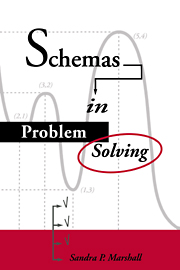Book contents
- Frontmatter
- Contents
- Preface
- Acknowledgments
- I Fundamentals
- II Schemas and instruction
- III Learning from instruction
- IV Schemas and assessment
- V Schema models
- 12 Production systems, neural networks, and hybrid models
- 13 The performance model
- 14 The learning model
- 15 The full schema model
- 16 Some concluding remarks on schema theory
- Notes
- References
- Name index
- Subject index
13 - The performance model
Published online by Cambridge University Press: 22 October 2009
- Frontmatter
- Contents
- Preface
- Acknowledgments
- I Fundamentals
- II Schemas and instruction
- III Learning from instruction
- IV Schemas and assessment
- V Schema models
- 12 Production systems, neural networks, and hybrid models
- 13 The performance model
- 14 The learning model
- 15 The full schema model
- 16 Some concluding remarks on schema theory
- Notes
- References
- Name index
- Subject index
Summary
In chapter 7, cognitive maps were introduced as representations of data. A cognitive map is a graph structure constructed from an individual's oral or written response. The map represents the main details of the response as nodes that are linked in a network, and it preserves the relationships among ideas–revealed in the responses–as links between nodes. An important feature of the cognitive map is the way in which linkages are determined: Two nodes are connected by a link only if the verbal details represented by those nodes occur together in the verbal response.
The cognitive maps and networks provide the means by which an individual's knowledge base can be represented, and they provide immediate information about the size of the individual's knowledge store (i.e., by the number of nodes) and about the coherence and integration of that knowledge store (i.e., by the number and pattern of links). Figure 13.1 shows again the basic network derived for the full instructional session of SPS, and Figure 13.2 reproduces the networks obtained from two student interviews.
As demonstrated previously, cognitive maps are useful as a basis for the examination of group responses. Thus, as I described earlier, we can study similarities and differences among different groups by aggregating general characteristics of students'maps. For example, cognitive maps can yield information about broad categories of responses, such as the impact of abstract and specific details (see chapter 7).
Information
- Type
- Chapter
- Information
- Schemas in Problem Solving , pp. 340 - 361Publisher: Cambridge University PressPrint publication year: 1995
